battery VOLVO XC70 2013 Owner´s Manual
[x] Cancel search | Manufacturer: VOLVO, Model Year: 2013, Model line: XC70, Model: VOLVO XC70 2013Pages: 382, PDF Size: 6.78 MB
Page 326 of 382
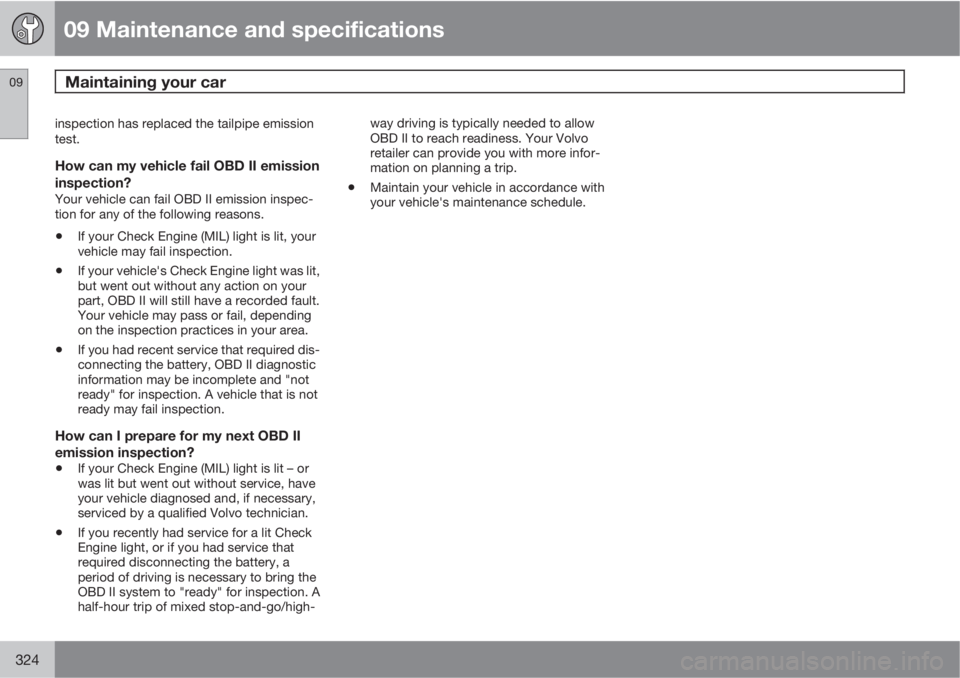
09 Maintenance and specifications
Maintaining your car 09
324
inspection has replaced the tailpipe emission
test.
How can my vehicle fail OBD II emission
inspection?
Your vehicle can fail OBD II emission inspec-
tion for any of the following reasons.
•If your Check Engine (MIL) light is lit, your
vehicle may fail inspection.
•If your vehicle's Check Engine light was lit,
but went out without any action on your
part, OBD II will still have a recorded fault.
Your vehicle may pass or fail, depending
on the inspection practices in your area.
•If you had recent service that required dis-
connecting the battery, OBD II diagnostic
information may be incomplete and "not
ready" for inspection. A vehicle that is not
ready may fail inspection.
How can I prepare for my next OBD II
emission inspection?
•If your Check Engine (MIL) light is lit – or
was lit but went out without service, have
your vehicle diagnosed and, if necessary,
serviced by a qualified Volvo technician.
•If you recently had service for a lit Check
Engine light, or if you had service that
required disconnecting the battery, a
period of driving is necessary to bring the
OBD II system to "ready" for inspection. A
half-hour trip of mixed stop-and-go/high-way driving is typically needed to allow
OBD II to reach readiness. Your Volvo
retailer can provide you with more infor-
mation on planning a trip.
•Maintain your vehicle in accordance with
your vehicle's maintenance schedule.
Page 327 of 382
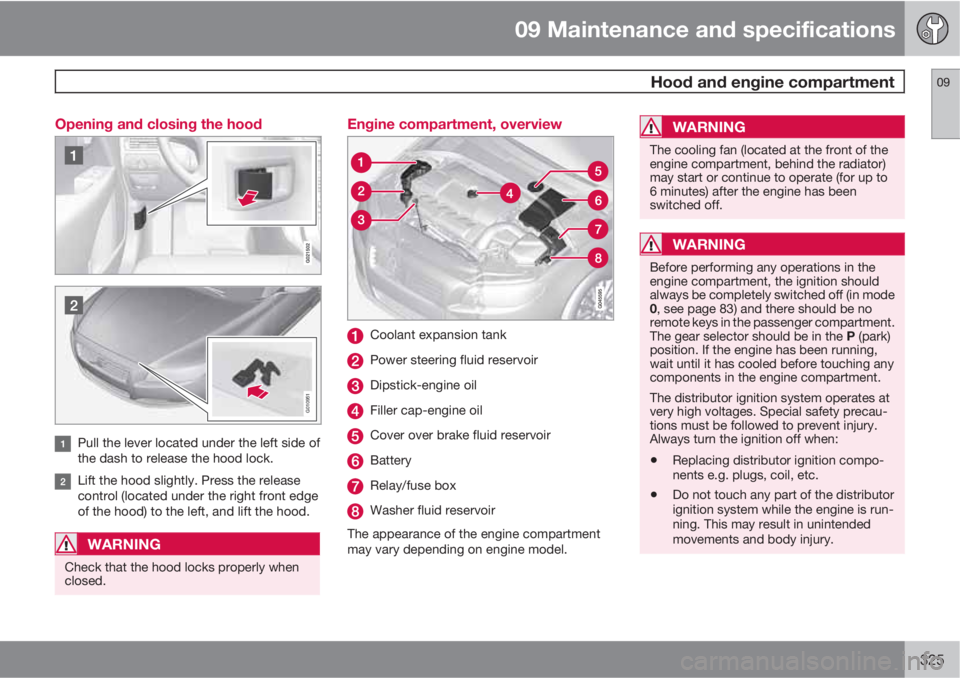
09 Maintenance and specifications
Hood and engine compartment09
325 Opening and closing the hood
G010951
Pull the lever located under the left side of
the dash to release the hood lock.
Lift the hood slightly. Press the release
control (located under the right front edge
of the hood) to the left, and lift the hood.
WARNING
Check that the hood locks properly when
closed.
Engine compartment, overview
Coolant expansion tank
Power steering fluid reservoir
Dipstick-engine oil
Filler cap-engine oil
Cover over brake fluid reservoir
Battery
Relay/fuse box
Washer fluid reservoir
The appearance of the engine compartment
may vary depending on engine model.
WARNING
The cooling fan (located at the front of the
engine compartment, behind the radiator)
may start or continue to operate (for up to
6 minutes) after the engine has been
switched off.
WARNING
Before performing any operations in the
engine compartment, the ignition should
always be completely switched off (in mode
0, see page 83) and there should be no
remote keys in the passenger compartment.
The gear selector should be in the P (park)
position. If the engine has been running,
wait until it has cooled before touching any
components in the engine compartment.
The distributor ignition system operates at
very high voltages. Special safety precau-
tions must be followed to prevent injury.
Always turn the ignition off when:
•Replacing distributor ignition compo-
nents e.g. plugs, coil, etc.
•Do not touch any part of the distributor
ignition system while the engine is run-
ning. This may result in unintended
movements and body injury.
Page 341 of 382
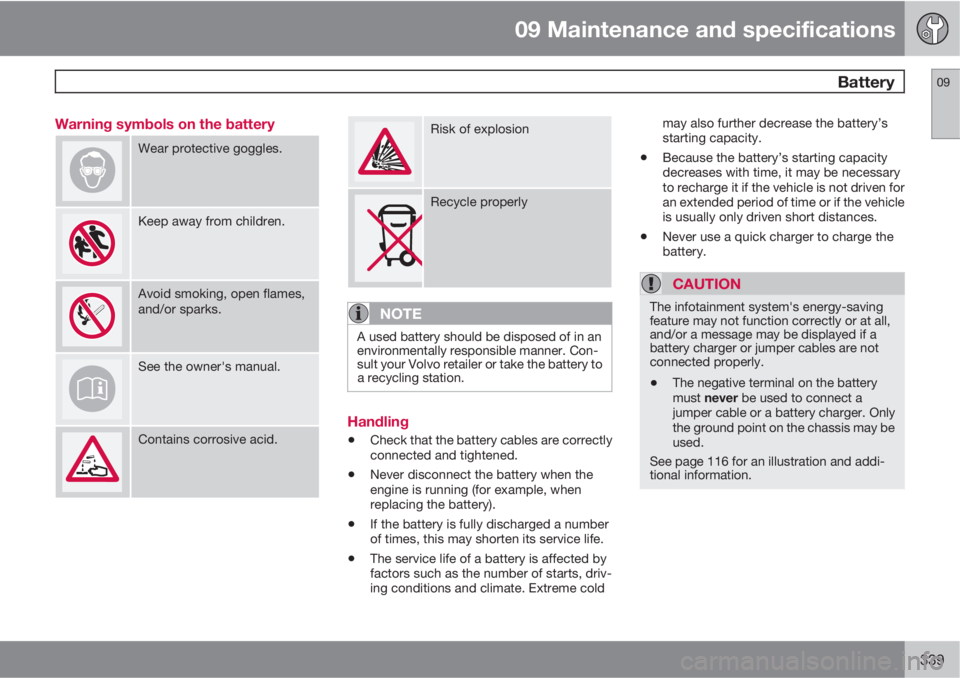
09 Maintenance and specifications
Battery09
339 Warning symbols on the battery
Wear protective goggles.
Keep away from children.
Avoid smoking, open flames,
and/or sparks.
See the owner's manual.
Contains corrosive acid.
Risk of explosion
Recycle properly
NOTE
A used battery should be disposed of in an
environmentally responsible manner. Con-
sult your Volvo retailer or take the battery to
a recycling station.
Handling
•Check that the battery cables are correctly
connected and tightened.
•Never disconnect the battery when the
engine is running (for example, when
replacing the battery).
•If the battery is fully discharged a number
of times, this may shorten its service life.
•The service life of a battery is affected by
factors such as the number of starts, driv-
ing conditions and climate. Extreme coldmay also further decrease the battery’s
starting capacity.
•Because the battery’s starting capacity
decreases with time, it may be necessary
to recharge it if the vehicle is not driven for
an extended period of time or if the vehicle
is usually only driven short distances.
•Never use a quick charger to charge the
battery.
CAUTION
The infotainment system's energy-saving
feature may not function correctly or at all,
and/or a message may be displayed if a
battery charger or jumper cables are not
connected properly.
•The negative terminal on the battery
must never be used to connect a
jumper cable or a battery charger. Only
the ground point on the chassis may be
used.
See page 116 for an illustration and addi-
tional information.
Page 342 of 382
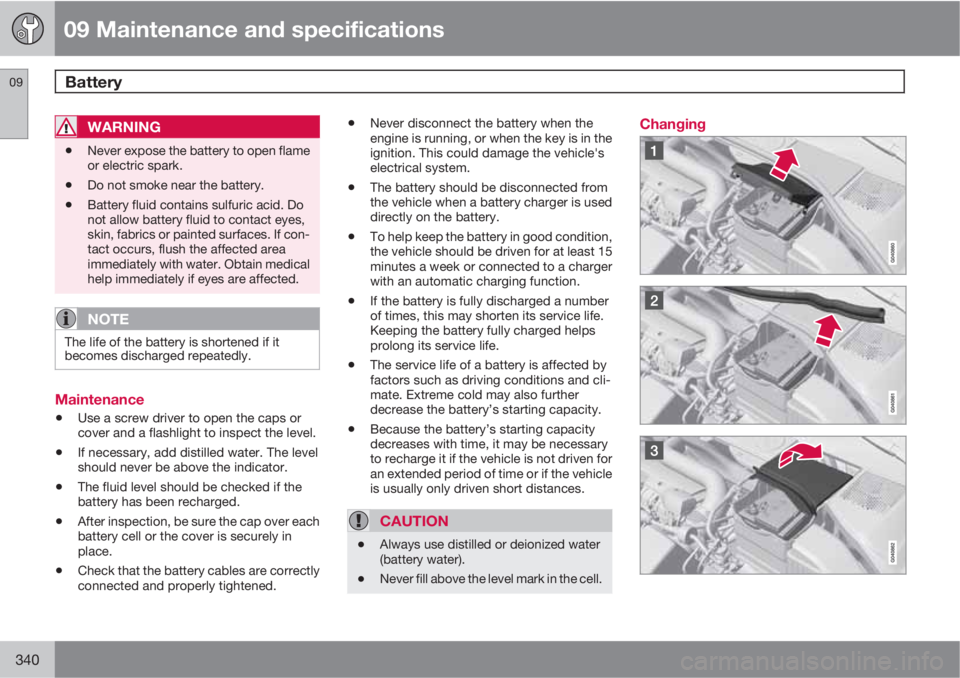
09 Maintenance and specifications
Battery 09
340
WARNING
•Never expose the battery to open flame
or electric spark.
•Do not smoke near the battery.
•Battery fluid contains sulfuric acid. Do
not allow battery fluid to contact eyes,
skin, fabrics or painted surfaces. If con-
tact occurs, flush the affected area
immediately with water. Obtain medical
help immediately if eyes are affected.
NOTE
The life of the battery is shortened if it
becomes discharged repeatedly.
Maintenance
•Use a screw driver to open the caps or
cover and a flashlight to inspect the level.
•If necessary, add distilled water. The level
should never be above the indicator.
•The fluid level should be checked if the
battery has been recharged.
•After inspection, be sure the cap over each
battery cell or the cover is securely in
place.
•Check that the battery cables are correctly
connected and properly tightened.
•Never disconnect the battery when the
engine is running, or when the key is in the
ignition. This could damage the vehicle's
electrical system.
•The battery should be disconnected from
the vehicle when a battery charger is used
directly on the battery.
•To help keep the battery in good condition,
the vehicle should be driven for at least 15
minutes a week or connected to a charger
with an automatic charging function.
•If the battery is fully discharged a number
of times, this may shorten its service life.
Keeping the battery fully charged helps
prolong its service life.
•The service life of a battery is affected by
factors such as driving conditions and cli-
mate. Extreme cold may also further
decrease the battery’s starting capacity.
•Because the battery’s starting capacity
decreases with time, it may be necessary
to recharge it if the vehicle is not driven for
an extended period of time or if the vehicle
is usually only driven short distances.
CAUTION
•Always use distilled or deionized water
(battery water).
•Never fill above the level mark in the cell.
Changing
Page 343 of 382
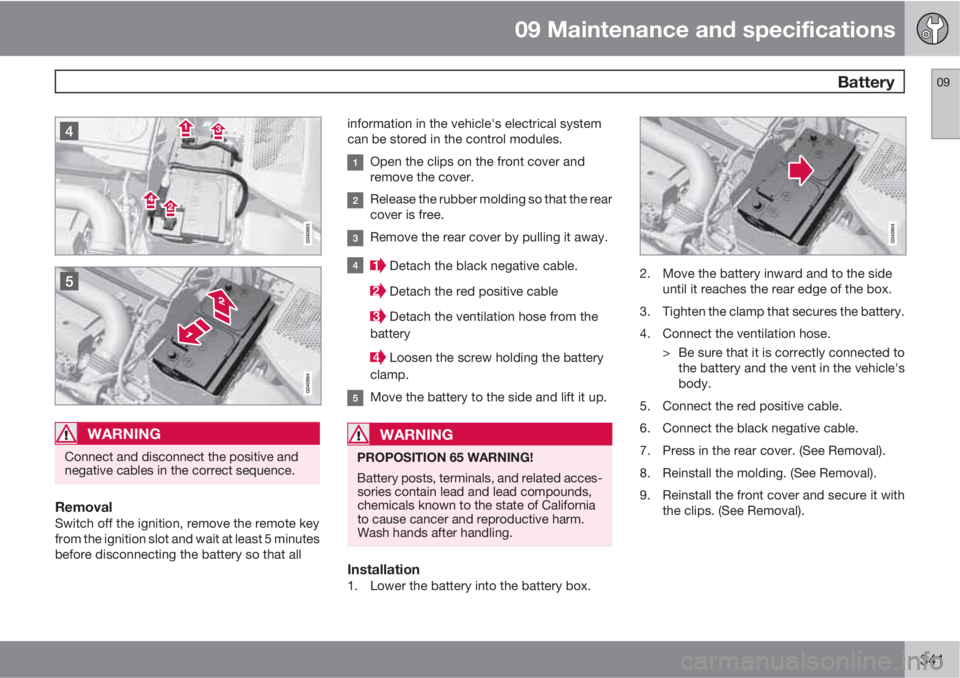
09 Maintenance and specifications
Battery09
341
WARNING
Connect and disconnect the positive and
negative cables in the correct sequence.
RemovalSwitch off the ignition, remove the remote key
from the ignition slot and wait at least 5 minutes
before disconnecting the battery so that allinformation in the vehicle's electrical system
can be stored in the control modules.
Open the clips on the front cover and
remove the cover.
Release the rubber molding so that the rear
cover is free.
Remove the rear cover by pulling it away.
Detach the black negative cable.
Detach the red positive cable
Detach the ventilation hose from the
battery
Loosen the screw holding the battery
clamp.
Move the battery to the side and lift it up.
WARNING
PROPOSITION 65 WARNING!
Battery posts, terminals, and related acces-
sories contain lead and lead compounds,
chemicals known to the state of California
to cause cancer and reproductive harm.
Wash hands after handling.
Installation1. Lower the battery into the battery box.
2. Move the battery inward and to the side
until it reaches the rear edge of the box.
3. Tighten the clamp that secures the battery.
4. Connect the ventilation hose.
> Be sure that it is correctly connected to
the battery and the vent in the vehicle's
body.
5. Connect the red positive cable.
6. Connect the black negative cable.
7. Press in the rear cover. (See Removal).
8. Reinstall the molding. (See Removal).
9. Reinstall the front cover and secure it with
the clips. (See Removal).
Page 367 of 382
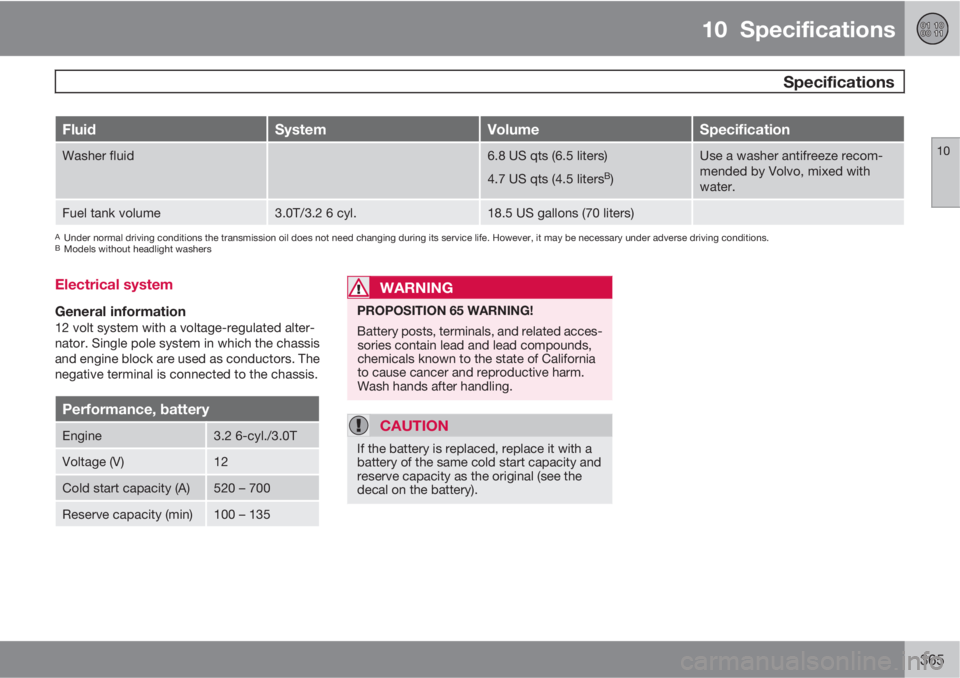
10 Specifications
Specifications
10
365
FluidSystemVolumeSpecification
Washer fluid6.8 US qts (6.5 liters)
4.7 US qts (4.5 liters
B)
Use a washer antifreeze recom-
mended by Volvo, mixed with
water.
Fuel tank volume3.0T/3.2 6 cyl.18.5 US gallons (70 liters)
AUnder normal driving conditions the transmission oil does not need changing during its service life. However, it may be necessary under adverse driving conditions.BModels without headlight washers
Electrical system
General information12 volt system with a voltage-regulated alter-
nator. Single pole system in which the chassis
and engine block are used as conductors. The
negative terminal is connected to the chassis.
Performance, battery
Engine3.2 6-cyl./3.0T
Voltage (V)12
Cold start capacity (A)520 – 700
Reserve capacity (min)100 – 135
WARNING
PROPOSITION 65 WARNING!
Battery posts, terminals, and related acces-
sories contain lead and lead compounds,
chemicals known to the state of California
to cause cancer and reproductive harm.
Wash hands after handling.
CAUTION
If the battery is replaced, replace it with a
battery of the same cold start capacity and
reserve capacity as the original (see the
decal on the battery).
Page 372 of 382
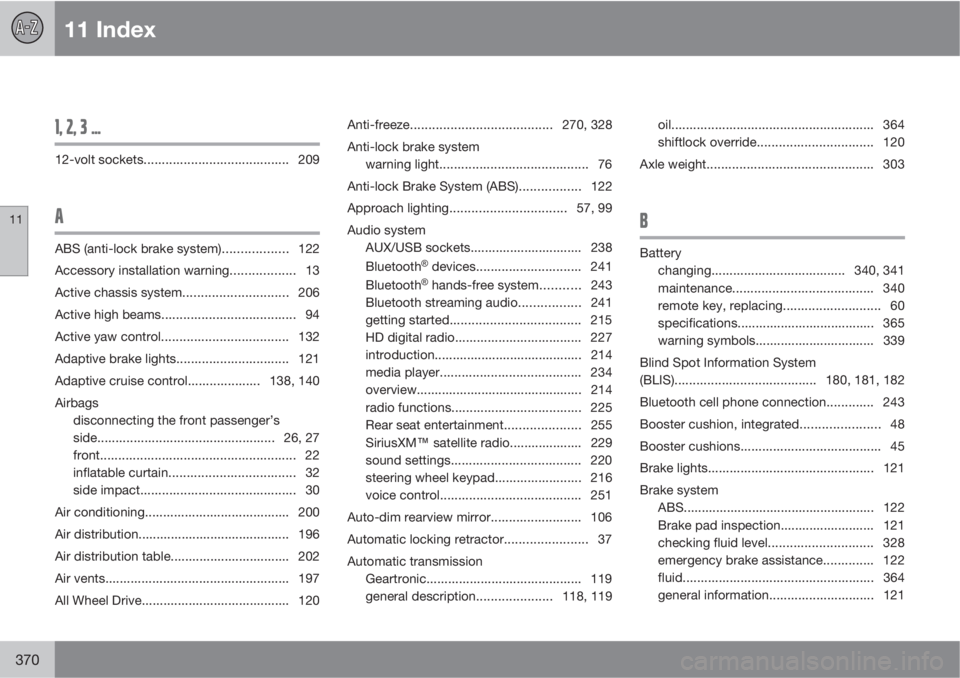
11 Index
11
370
1, 2, 3 ...
12-volt sockets........................................ 209
A
ABS (anti-lock brake system).................. 122
Accessory installation warning.................. 13
Active chassis system.............................206
Active high beams..................................... 94
Active yaw control................................... 132
Adaptive brake lights............................... 121
Adaptive cruise control.................... 138, 140
Airbags
disconnecting the front passenger’s
side.................................................26, 27
front...................................................... 22
inflatable curtain................................... 32
side impact........................................... 30
Air conditioning........................................ 200
Air distribution.......................................... 196
Air distribution table................................. 202
Air vents................................................... 197
All Wheel Drive......................................... 120Anti-freeze.......................................270, 328
Anti-lock brake system
warning light......................................... 76
Anti-lock Brake System (ABS)................. 122
Approach lighting................................57, 99
Audio system
AUX/USB sockets............................... 238
Bluetooth�Ÿ devices............................. 241
Bluetooth�Ÿ hands-free system........... 243
Bluetooth streaming audio................. 241
getting started.................................... 215
HD digital radio................................... 227
introduction......................................... 214
media player....................................... 234
overview.............................................. 214
radio functions.................................... 225
Rear seat entertainment..................... 255
SiriusXM
E satellite radio.................... 229
sound settings.................................... 220
steering wheel keypad........................ 216
voice control....................................... 251
Auto-dim rearview mirror......................... 106
Automatic locking retractor....................... 37
Automatic transmission
Geartronic........................................... 119
general description.....................118, 119oil........................................................ 364
shiftlock override................................ 120
Axle weight.............................................. 303
B
Battery
changing..................................... 340, 341
maintenance....................................... 340
remote key, replacing........................... 60
specifications...................................... 365
warning symbols................................. 339
Blind Spot Information System
(BLIS)....................................... 180, 181, 182
Bluetooth cell phone connection............. 243
Booster cushion, integrated...................... 48
Booster cushions....................................... 45
Brake lights.............................................. 121
Brake system
ABS..................................................... 122
Brake pad inspection.......................... 121
checking fluid level............................. 328
emergency brake assistance.............. 122
fluid..................................................... 364
general information............................. 121
Page 378 of 382
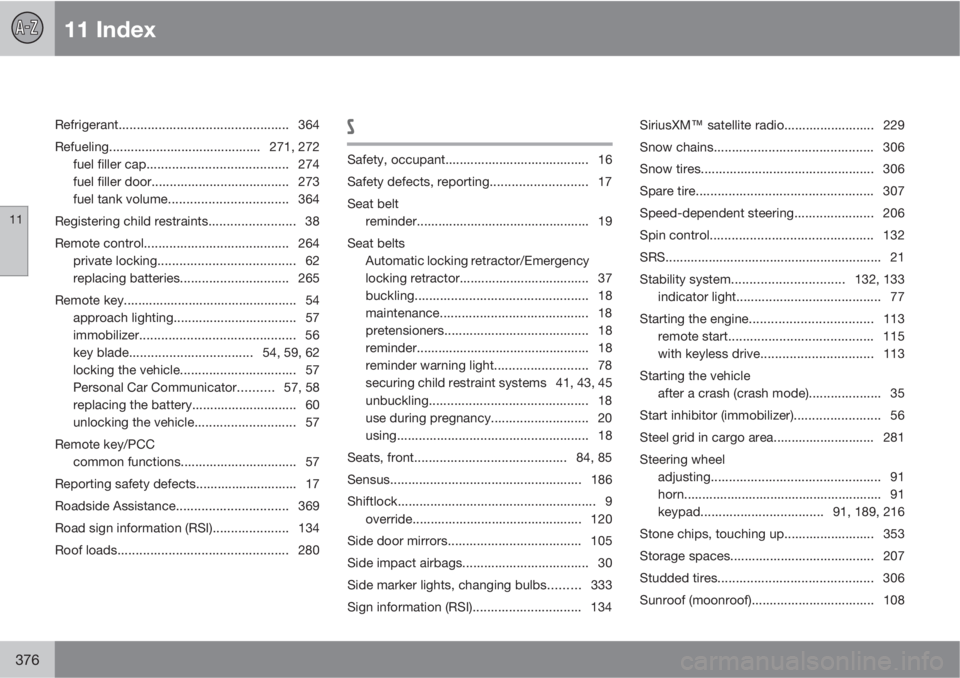
11 Index
11
376
Refrigerant............................................... 364
Refueling..........................................271, 272
fuel filler cap....................................... 274
fuel filler door...................................... 273
fuel tank volume.................................364
Registering child restraints........................ 38
Remote control........................................ 264
private locking...................................... 62
replacing batteries.............................. 265
Remote key................................................ 54
approach lighting.................................. 57
immobilizer........................................... 56
key blade..................................54, 59, 62
locking the vehicle................................ 57
Personal Car Communicator..........57, 58
replacing the battery............................. 60
unlocking the vehicle............................ 57
Remote key/PCC
common functions................................ 57
Reporting safety defects............................ 17
Roadside Assistance............................... 369
Road sign information (RSI)..................... 134
Roof loads............................................... 280S
Safety, occupant........................................ 16
Safety defects, reporting........................... 17
Seat belt
reminder................................................ 19
Seat belts
Automatic locking retractor/Emergency
locking retractor.................................... 37
buckling................................................ 18
maintenance......................................... 18
pretensioners........................................ 18
reminder................................................ 18
reminder warning light.......................... 78
securing child restraint systems 41, 43, 45
unbuckling............................................ 18
use during pregnancy........................... 20
using.....................................................18
Seats, front.......................................... 84, 85
Sensus.....................................................186
Shiftlock....................................................... 9
override............................................... 120
Side door mirrors..................................... 105
Side impact airbags................................... 30
Side marker lights, changing bulbs......... 333
Sign information (RSI).............................. 134SiriusXM
E satellite radio......................... 229
Snow chains............................................ 306
Snow tires................................................ 306
Spare tire................................................. 307
Speed-dependent steering...................... 206
Spin control............................................. 132
SRS............................................................ 21
Stability system...............................132, 133
indicator light........................................ 77
Starting the engine..................................113
remote start........................................ 115
with keyless drive...............................113
Starting the vehicle
after a crash (crash mode)....................35
Start inhibitor (immobilizer)........................ 56
Steel grid in cargo area............................ 281
Steering wheel
adjusting............................................... 91
horn....................................................... 91
keypad.................................. 91, 189, 216
Stone chips, touching up......................... 353
Storage spaces........................................ 207
Studded tires........................................... 306
Sunroof (moonroof).................................. 108